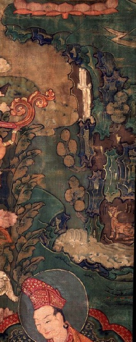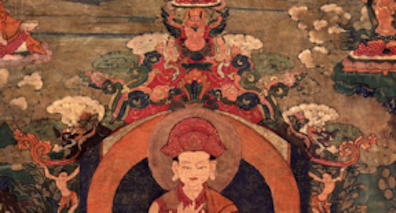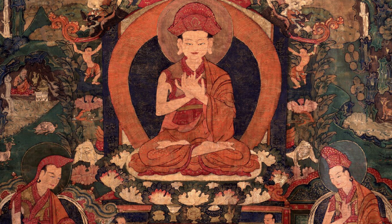

This painting evokes the richness of Drigung painting traditions. It depicts Drigung Jigten Sumgön, the central figure, with two much later abbots of Drigung. The two lesser lamas to his left and right are Drigung Rigdzin Chökyi Drakpa (1595″“1659, twenty-fifth abbot) and Könchok Trinle Zangpo (1656-1718, twenty-sixth abbot). These two later lamas were famous as patrons of art or as highly skilled artists themselves. Könchok Trinle Zangpo in particular was known for his thangkas and for teaching his disciples in the art of painting. It is thus wonderful to find him personally represented here in this thangka, as its final (and historically most recent) lama. The piece incorporates many interesting stylistic features that lead me to believe that it exemplifies the Drigung artistic style of the late-17th and early-18th centuries—the early Drigung style associated with Könchok Trinle Zangpo and his circle.
When examined closely, the painting also reveals a high level of artistry and a wealth of interesting details, including the main figures’ exactly rendered hats. White mountain waterfalls descend prominently on either side of the landscape near the horizon and a third flows a bit lower on the left, jetting from the wall in the cave of a hermit, who pors water oblations as part of his ritual practice.

Another striking detail is the backrest above the pink halo of the central lama, a thin strip of which is painted vermilion red. The upper edges of that red area are defined by the ornately convoluted tails of a makara sea monster, one of which is found on either side of the backrest. Such elegant throne-back decorations are reminiscent of paintings executed in the Khyenri style, which reveals information about the painter’s stylistic roots.

The painting possesses distinctive clouds and skies that also may have descended (in part) from the Khyenri. The clouds in the sky are of a type not typically seen in the Menri paintings of Central Tibet in the standard Eri style. The upper sky has a greyish base color and is filled with special flat-lying dentate clouds with borders and gaps painted with indigo. A series of yet another cloud type forms a second elegant border for the throne-back of the main figure.
This painting seems to exemplify the period when Könchok Trinle commissioned many paintings in this and similar styles. Viewers find variability in the decorative elements, such as landscapes. The coloring of cloud clusters is variable, and colors sometimes alternate from cluster to cluster. Each cluster can possess as many as three horizontal layers, though they lack the large dark “cloud-eye” holes of the standard Eri style of Lhasa.
I never tire of exploring this painting, which continues to offer visual and contextual surprises each time I view it.

